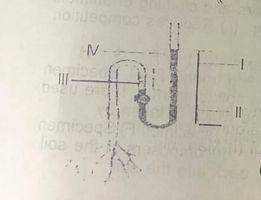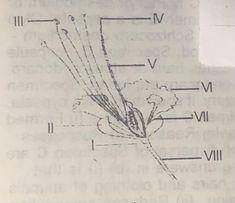(a) (i) identify specimens A. B, C, D and E (ii) To which class of fruits does each specimen belong? (iii) Give two reasons each for your answers (b) Examine specimen C carefully (i) State the agent of dispersal of specimen C (ii) Give one structural feature of specimen C carefully (iii) State the agent of dispersal of specimen C (iv) Give one structural feature of specimen C to support your answer (c) State two advantages of dispersal of fruit and seeds
Name the physical processes responsible for the following (a) entry of carbon dioxide into the leaf through the stomata (b) entry of soil water into the root hair (c) shrinkage of plant tissue in hypertonic sugar solution
Explain briefly how a large quantity of dead organic materials dumped into a river can be harmful to aquatic life.
(a) State two ways in which the mesophyll layer of the leaf is adapted for photosynthesis (b) In the test for starch in a leaf, why is the leaf boiled in warm alcohol?

Study the diagram below and use it to answer questions (a)-(d)
(a) Name the set-up illustrated in the diagram (b) What is the apparatus used for? (c) What is contained in the part of the apparatus labelled IV? (d) From which part(s) of the apparatus would the reading(s) be taken after the experiment?

Which of the labellled parts represent the (a) female reproductive system (b) petal?
(a) Explain the following terms: (i) voluntary action. (ii) involuntary action.
(b) State three functions each of: (I) insulin; (ii) auxins.
(c) Describe an experiment to show that plant roots respond positively to gravity.
(a) Mention six ways by which the government is contributing towards self-sufficiency in food production
(b) List five methods Of conserving soil fertility.
(c) Explain how three named agricultural practices can destroy the balance of an ecosystem.
(a) Describe briefly the female reproductive system of a named mammal. (A diagram is essential).
(b) List three differences between reproduction in mammals and in amphibians.
(c) Describe the structure and function of the male reproductive organ of a flowering plant.
(a) List the principal sense organs in mammals and their functions.
(b) (i) Describe the eye defect in which only distant objects are seen clearly.
(ii) How can it be corrected? Illustrate your answer with labelled diagrams.
(c) Make a large diagram of the vertical section through the mammalian skin.
The property of clay soil that prevents it from supporting thick vegetation is its
- A. possession of chemically weathered granite rocks
- B. inability to retain much water
- C. tendency of becoming waterlogged
- D. porosity and low water retention ability
- E. high capillary spaces between the soil particles
Lamarck’s evolution theory could be summarised by the statement that
- A. only the fittest can survive in a challenging environment
- B. species that are unable to adapt become extinct
- C. new characteristics do not arise in organisms in time of need
- D. the changing environment imposes structural physiological and behavioural changes in organisms
- E. in a changing and unstable environment nature rejects the weak
The swarming especially at the beginning of the rainy season is a courtship behaviour shown by
- A. migratory birds
- B. pigeons
- C. crickets
- D. winged termites
- E. bees
The division of labour in social insects is an example of
- A. structural adaptation
- B. physiological adaptation
- C. commensalism
- D. behavioural adaptation
- E. hormonal influence
The changing of colour by a chameleon to that of the environment is an example of
- A. adaptive radiation
- B. protective coloration
- C. courtship display
- D. display of body colour
- E. territorial behaviour
Which of the following does not illustrate adaptation to the environment ?
- A. Colour chanages by chameleon
- B. Streamline shape of fishes
- C. Light bones in birds
- D. Development of big muscies by a weight lifter
- E. Possession of fins by fishes



